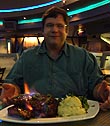 |
|
 Home Home
 Products Products
 Store Store
 Forum Forum
 Warehouse Warehouse
 Contact Us Contact Us

|
|
|
|
 
|
|
Author
|
Topic: CFS Automation Manual?
|
|
|
Darryl Spicer
Film God

Posts: 3250
From: Lexington, KY, USA
Registered: Dec 2000
|
 posted 08-04-2001 11:17 PM
posted 08-04-2001 11:17 PM



are these CFS automations in consoles. THe ones that I am familiur with are in consoles. What type cue detectors are you using. Are they the Component engineering proxemity cue detectors or the kelmar cue detectors with the drop down fingers for failsafe. Here is a cue placement description that can be tried.On the CFS automation place the switch that says intermission/spare cue in the spare cue mode. put and inboard (soundtrack side) cue at the end of your trailers. This should cue the lights all the way down. At the begining of the credits place a cross cue or center cue on the film. Cross cue will use four strips of cue tape accross one frame. Center cue will use a small four sprocket holes wide cue down center of picture on both sides. At the end of credits place an inboard cue (opposit soundtrack side of film this should shut down the pictures and sound. all depends on if everything is set up corectly.
| IP: Logged
|
|
|
|
Aaron Sisemore
Flaming Ribs beat Reeses Peanut Butter Cups any day!

Posts: 3061
From: Rockwall TX USA
Registered: Sep 1999
|
 posted 08-05-2001 12:54 PM
posted 08-05-2001 12:54 PM




Now that we know what you have, here is your solution:Cues and their functions: Assuming you have a half-light dimming system (CFS dimmers-the auto should have a red button that says 'manual center cue' on it somewhere), the function switch should be set to SPARE CUE at all times.
- Start[button]+7sec: Dowser opens, sound switches from non-sync to optical. Lights drop to half brightness (if the dimmers support it, otherwise they drop fully). Slide projector (when equipped) will shut off.
- 'Outboard' cue (soundtrack side usually placed between the last trailer and the feature or policy snipe): Changes sound formats (if equipped to do so), dims lights fully (if half-light equipped), executes a real or 'phoney' turret change (if wired for auto turrets).
- 'Center' Cue (a 1/4 to 1/2" cue usually placed at the beginning of the credits, across the frame line if possible): Lights up to 1/2 (if equipped to do so).
- 'Inboard' Cue(non-soundtrack side usually placed at the blue rating band): Closes dowser, changes sound back into non-sync, turns on slide projector, brings lights up full.
As for the subject of slide projectors with CFS autos: If the console was not factory wired with a slide projector outlet somewhere on the console, usually at the front (many are-in that case it should be 'plug-n-play'), heres is how to wire it up:The following is for individuals with experience in wiring 110VAC line current-If you have any doubts contact an experienced electrician or cinema technician for assistance Disconnect all power from the console. Run a wire from a 110v source (the cold side of the 'ACC' breaker on the console is a good place to get the current). On the automation circuit board there is a terminal strip with many wires coming from it. near one end are three terminals labeled 'HELD CONTACTS' (N.O., COM, and N.C.). ***WARNING*** Some sound system format controls (early Ultra*Stereos and Smart MODII's come immediately to mind) may use the 'held contacts' to control format changes. if there are any wires already connected to the 'held contacts' terminals, DO NOT attempt to connect 110VAC to the terminals!!! Trace the wiring and try to move the controls for the sound formats to another place (see the automation schematic for more details) Connect the wire coming from the breaker to the N.O. terminal. Run another wire from the N.C. terminal to an outlet that you will use for the slide projector. [This is how the factory wiring is done with these consoles for slides] Connect the wire at the outlet to the 'hot' (usually the brass terminal) side of the outlet. Connect a wire to the neutral side (usually silver) of the outlet and find a suitable neutral connection to connect the other side of this wire. Plug in the slide projector and test. it should follow the functions listed above.
Good Luck!
Aaron
| IP: Logged
|
|
|
|
|
|
All times are Central (GMT -6:00)
|
|
Powered by Infopop Corporation
UBB.classicTM
6.3.1.2
The Film-Tech Forums are designed for various members related to the cinema industry to express their opinions, viewpoints and testimonials on various products, services and events based upon speculation, personal knowledge and factual information through use, therefore all views represented here allow no liability upon the publishers of this web site and the owners of said views assume no liability for any ill will resulting from these postings. The posts made here are for educational as well as entertainment purposes and as such anyone viewing this portion of the website must accept these views as statements of the author of that opinion
and agrees to release the authors from any and all liability.
|
|
|
|

 Home
Home
 Products
Products
 Store
Store
 Forum
Forum
 Warehouse
Warehouse
 Contact Us
Contact Us




 Printer-friendly view of this topic
Printer-friendly view of this topic











